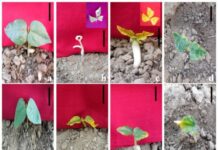A recent study by Igiebor, et al. (2024) titled “Impact of plant-based nanoparticles synthesized from Carica papaya and Bryophyllum pinnatum against selected microorganisms” published in Studia Universitatis Babeş-Bolyai, Biologia, examines that synthesized nanoparticles showed significant antimicrobial activity against multiple antibiotic-resistant bacteria, including S. aureus, E. coli, P. aeruginosa, H. pylori, and B. alvei.
“
Plant-based silver and copper nanoparticles effectively combat antibiotic-resistant bacteria, showing significant antimicrobial activity and potential.-Igiebor, et al. 2024
The study examines the antimicrobial effects of nanoparticles synthesized from Carica papaya and Bryophyllum pinnatum against specific microorganisms. It focuses on the antimicrobial properties of silver and copper nanoparticles (AgNPs and CuNPs) derived from these plant extracts. The nanoparticles were tested against five clinical isolates and demonstrated significant antimicrobial activity, effectively inhibiting the growth of multiple antibiotic-resistant bacteria. The findings suggest that plant-mediated nanoparticles could serve as a sustainable and eco-friendly alternative to traditional antimicrobial agents. However, further research is necessary to evaluate their safety and effectiveness in clinical applications.
How the study was conducted
The synthesis of nanoparticles began with the preparation of plant extracts from Carica papaya and Bryophyllum pinnatum. These extracts were utilized to synthesize silver and copper nanoparticles (AgNPs and CuNPs). The authors characterize the nanoparticles using various techniques, including UV-Vis spectroscopy, X-ray diffraction (XRD), and scanning electron microscopy (SEM), to confirm their formation and analyze their properties. The antimicrobial activity of the synthesized nanoparticles was then tested against five clinical isolates using standard antimicrobial assays. The authors thoroughly analyzed the results of these tests to evaluate the effectiveness of the nanoparticles in inhibiting bacterial growth. This comprehensive methodology enabled the researchers to assess the potential of plant-based nanoparticles as effective antimicrobial agents.
What the authors found
The authors found that synthesized nanoparticles showed significant antimicrobial activity against multiple antibiotic-resistant bacteria, including S. aureus, E. coli, P. aeruginosa, H. pylori, and B. alvei, and then both silver (AgNPs) and copper nanoparticles (CuNPs) synthesized from the plant extracts were effective, with CuNPs showing slightly better inhibition levels. In addition, the authors found that plant extracts alone did not inhibit bacterial activity, highlighting the importance of nanoparticle synthesis.
Why is this important?
Antibiotic Resistance: With the rise of antibiotic-resistant bacteria, finding new and effective antimicrobial agents is crucial. The study’s findings suggest that plant-based nanoparticles could be a viable alternative to traditional antibiotics.
Sustainability: The use of plant extracts for nanoparticle synthesis is eco-friendly and sustainable. This method reduces the reliance on chemical processes that can be harmful to the environment.
Innovation in Medicine: The study opens up new avenues for research in nanomedicine. Plant-mediated nanoparticles could potentially be used in various medical applications, including drug delivery and wound healing.
Cost-Effectiveness: Using readily available plant materials for nanoparticle synthesis can be more cost-effective compared to conventional methods, making it accessible for wider use, especially in resource-limited settings.
Safety and Efficacy: Although further research is needed, the study provides a foundation for assessing the safety and efficacy of these nanoparticles in clinical settings, potentially leading to new treatments for bacterial infections.
What the authors recommended
- The authors suggest conducting more extensive studies to fully understand the safety and efficacy of plant-based nanoparticles in clinical settings.
- The study recommends initiating clinical trials to evaluate the potential of these nanoparticles as alternative antimicrobial agents.
- The authors encourage exploring other plant species for nanoparticle synthesis to identify more effective and diverse antimicrobial agents.
- They highlight the need for studies on the environmental impact of using plant-based nanoparticles to ensure they are truly sustainable and eco-friendly.
In conclusion, the study by Igiebor et al. (2024) underscores the promising potential of plant-based silver and copper nanoparticles synthesized from Carica papaya and Bryophyllum pinnatum as effective antimicrobial agents against antibiotic-resistant bacteria. The significant antimicrobial activity demonstrated by these nanoparticles highlights their potential as sustainable and eco-friendly alternatives to traditional antibiotics. While the study paves the way for innovative applications in nanomedicine, further research and clinical trials are essential to fully assess their safety, efficacy, and practical applications. As the search for new solutions to combat antibiotic resistance continues, plant-based nanoparticles offer a promising avenue for developing cost-effective and sustainable treatments.
















 The African Research (AR) Index is a comprehensive scholarly directory and database focused explicitly on journal publishers that publish and disseminate African research.
The African Research (AR) Index is a comprehensive scholarly directory and database focused explicitly on journal publishers that publish and disseminate African research.

